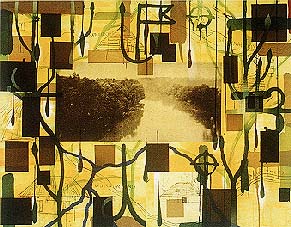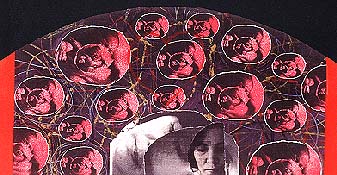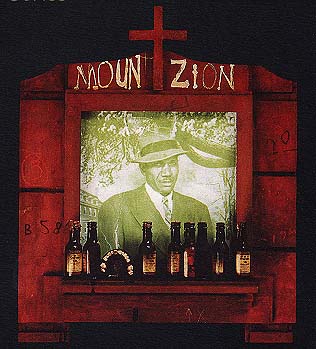

February Issue 2001
Center for Documentary Studies in Durham, NC, Features Personal Histories Exhibition
The three artists featured in Personal Histories, a new exhibition at the Center for Documentary Studies at Duke University in Durham, NC, on view through Mar. 30, all draw upon their own lives in the creative process. Radcliffe Bailey, Juan Sanchez, and Renée Stout incorporate family or found photographs in their artwork, using them in various ways to examine and express their identities and their ethnic heritage. Through photographs, text, mixed media, and construction, these artists are defining who they are and where they have come from, while also giving voice to their ancestors. They use recovered images as a starting place to emphasize or inform their work. They ask questions about memory. What do we really "remember" or "gain" by searching the details of a family portrait? Bringing to light an individual identity or narrative, they seem to be saying, represents the collective memory for an entire people.
These artists approach the photograph and its
multiple possibilities for self-exploration and self-image in
provocative ways. Over the years the Center for Documentary Studies
has initiated and supported projects that encourage young people
to make images of themselves and their world and to paint and
write on these images as a means of self-exploration. The work
of these three artists invites viewers to consider how everyone's
personal history can be explored using a varied set of documentary
tools.
The exhibition is accompanied by a film series (listed below)
and a companion exhibit, A Community Portrait, which will
provide an opportunity for school and community groups and other
visitors to engage in the ideas and themes raised by Personal
Histories. Participants will provide a family photograph and
participate in one of three workshops to create and share writings
about their photos. The photographs and writings will be presented
in A Community Portrait.
Personal Histories was curated by Susan Page. This project received support from the NC Arts Council, an agency funded by the state of NC and the National Endowment for the Arts. The exhibition and its associated programs are also supported by the Lyndhurst Foundation.
The Three Artists
 Radcliffe Bailey
Radcliffe Bailey
Born in New Jersey in 1968 and now living in Atlanta, Georgia,
Radcliffe Bailey finds inspiration in both African and African
American cultures. Bailey's colorful mixed media pieces are centered
on vintage photographs from his collection of family images, surrounded
by vibrant geometric shapes (recalling quilt patterns as well
as abstract expressionist painting). Bailey often includes ritual
objects in his work, referencing African minkisi figures. He explores
the ideas of migration, both physical and spiritual, and the many
manifestations of freedom and enslavement over time. He is also
greatly influenced by music, and his artwork projects the energy
and interplay of a sort of visual sound. Choruses from spirituals
inspired four pieces in the Personal Histories exhibition,
from his Until I Die series. To Bailey, painting and music
share a creative process best likened to a jazz musician's search
for the right sound through improvisation. "What I do may
not even be called art," he has said. "It may be called
music."
 Juan Sanchez
Juan Sanchez
Born in 1954 in Brooklyn, New York, to Afro-Puerto Rican parents,
Juan Sanchez layers his artwork with references to multiple cultural
experiences from his own history and that of the Puerto Rican
people. Using old family photographs, Taino symbols, Afro-Caribbean
religious imagery, portraits of Puerto Rican patriots, crosses,
and many other icons, he creates personal and collective narratives
with a social and political consciousness. Sanchez's political
convictions, shaped early by the working-class neighborhoods where
he grew up and his involvement with Puerto Rican activist organizations
as a youth, are expressed through his art. Art, he believes, has
impact. It can transform individual and community lives. Sanchez
calls his mixed media works RICAN/STRUCTIONS, a term coined by
the salsa jazz musician Ray Barretto, reflecting the artist's
commitment to redefining false assumptions. "We as a people
must deconstruct the colonized history that is oppressing us and
reconstruct the false 'reality' to give testimony to our real
history and truths," he has said. "We must re-create
ourselves and give light to our virtues and strength in order
to really appreciate who we are and be proud of it."
 Renée Stout
Renée Stout
Renée Stout grew up in Pittsburgh but moved to Washington,
D.C., in 1985, when she was in her late twenties. Because she
does not have her own family photograph albums to draw upon, Stout
uses found photographs in her work, instilling them with character
and meaning through mixed media assemblages of objects and structures.
Stout's artwork has often explored African healing myths, rituals,
and traditions within the context of contemporary social problems.
In some of her work, Stout has examined the violence of urban
American street life along with various struggles for justice
and freedom by minorities over time.
She writes, "Several years ago I was told an African proverb that has become a mantra that I live by: 'Until the lions tell their own histories, tales of hunting will always glorify the hunter.'"
"At this stage in my career as an artist, I feel that I have a responsibility to bear witness to the ways historical and current social and political events affect me and the community I am a part of. Through my creative process I deal literally and metaphorically with all the joy, pain, love, anger, frustration, hope, and fear that living in these strange and surreal times can bring. But, my work is also about paint, wood, color, dirt, texture, the "what-ifs," the possibilities and alternative ways of seeing.
"Influenced by the blues musicians and singers that have come before me, I consider myself a 'visual bluesist' because I work from a blues aesthetic. This aesthetic allows me to find humor, beauty, and transcendence in even the most adverse situations. It has also allowed me to hold on to and celebrate all that is human, spiritual, and sensual in a technological age that seems determined to remove from our lives all that is human, spiritual, and sensual."
A Community Portrait in the Lounge Gallery at CDS
The Center for Documentary Studies invites participation in the installation of A Community Portrait, a companion exhibition organized in conjunction with Personal Histories. This continuous installation will occur simultaneously in two exhibition spaces: the Lounge Gallery at CDS and on-line at the Personal Histories web site at (http://cds.aas.duke.edu/personal histories). A Community Portrait will provide an environment for school and community groups and other visitors to actively engage in the ideas and themes raised by Personal Histories.
Participants provided a family photograph and participated in one of three workshops, community events bringing together individuals of various ages and cultures to create and share writings about contributed photographs. The workshops explored examples of interaction between text and photos and themes of identity, memory, and personal history. The photographs are displayed in the gallery version of A Community Portrait, along with portions of the text, creating a growing collection that documents the local community through individual and family stories.
The Web version of A Community Portrait includes photographs and text from participants in the Triangle area as well as contributions from those who live farther away and cannot visit CDS in person. In you wish to contribute, check the "Personal Histories" Web site for details on the submission process.
Personal Histories Film Series at CDS
In conjunction with the exhibition Personal Histories (Through Mar. 30), the Center for Documentary Studies is screening seven award-winning films that tell individual stories of diverse lives and cultures. These Thursday night screenings, all beginning at 7pm, are free and open to the public. The screenings are co-sponsored by the DoubleTake Documentary Film Festival, which is produced in association with the Center for Documentary Studies.
February 8
In Search of Our Fathers (1991,55 mm.)
African American filmmaker Marco Williams was twenty-four when
he first learned his father's name. He had been raised in a close-knit
family where for generations strong, husbandless mothers were
the norm and fathers disappeared. This film documents his seven-year
search for his father and his coming to terms with the truth of
his origins. The quest actually brings him closer to his mother,
whose resourcefulness enabled both of them to improve their lives.
Oma Rhee (1999,
20 mm.)
Narrated by her four grown daughters, the story of Oma Rhee is
not a happy one. The film begins as the sisters relive childhood
memories of family trips taken out West, the deterioration of
their parents' arranged marriage, and ultimately their mother's
suicide. Directed by Rosylyn Rhee, this warm and sensitive film
lends fascinating insight into the experiences of a Korean American
family.
March 8
The Devil Never Sleeps (1996, 56 mm)
Academy Award-nominated filmmaker Lourdes Portillo mines the complicated
intersections of analysis and autobiography, evidence and hypothesis,
even melodrama and police procedure in this highly original work.
The filmmaker returns to Mexico, the land of her birth, to investigate
her uncle's identity and death, which has occurred under questionable
circumstances. Portillo blends traditional and experimental techniques
to capture the nuances of Mexican social and family order.
The Body Beautiful
(1991,23 mm)
This bold, stunning exploration of a white mother who undergoes
a radical mastectomy and her black daughter who embarks on a modeling
career reveals the profound effects of body image and the strain
of racial and sexual identity on their charged, loving bond. The
filmmaker, Ngozi Onwurah, weaves memory and fantasy as she explores
the depths of maternal strength and daughterly devotion.
March 22
Osaka Story
(1994, 75 mm)
After three years abroad, filmmaker Toichi Nakata comes home to
Osaka and turns his camera on his family, exposing all its hidden
fault lines. Nakata's father, a Korean Immigrant, cannot reconcile
his Korean and his wife's Japanese families. Nakata's mother is
preoccupied with her social status; his brother is torn between
the family business and a cult religious sect; and his sister
has forsaken the family altogether.
Fighting Grandpa
(1998, 21 mm.)
Korean American filmmaker Grek Pak creates a touching meditation
on the human heart in Fighting Grandpa. He tells the story
of his immigrant grandmother's seventy-year struggle with her
husband. Forced to give up her dreams of becoming a nurse, left
with four children for ten years alone on Korea while her husband
studies in America, and finally brought to Hawaii to endure new
hardships created in part by her husband's parsimonious ways,
Grandma had every right to be bitter. But, as the filmmaker discovers,
questions of love have no simple answers.
For more information, call CDS at 919/660-3663,
e-mail to (dkdreyer@duke.edu) or at (http://cds.ass.duke.edu).
Mailing Address: Carolina Arts, P.O. Drawer
427, Bonneau, SC 29431
Telephone, Answering Machine and FAX: 843/825-3408
E-Mail: carolinart@aol.com
Subscriptions are available for $18 a year.
Carolina Arts
is published monthly by Shoestring
Publishing Company, a subsidiary of PSMG, Inc.
Copyright© 2001 by PSMG, Inc., which published Charleston
Arts from July 1987 - Dec. 1994 and South Carolina Arts
from Jan. 1995 - Dec. 1996. It also publishes Carolina Arts
Online, Copyright© 2001 by PSMG, Inc. All rights reserved
by PSMG, Inc. or by the authors of articles. Reproduction or use
without written permission is strictly prohibited. Carolina
Arts is available throughout North & South Carolina.